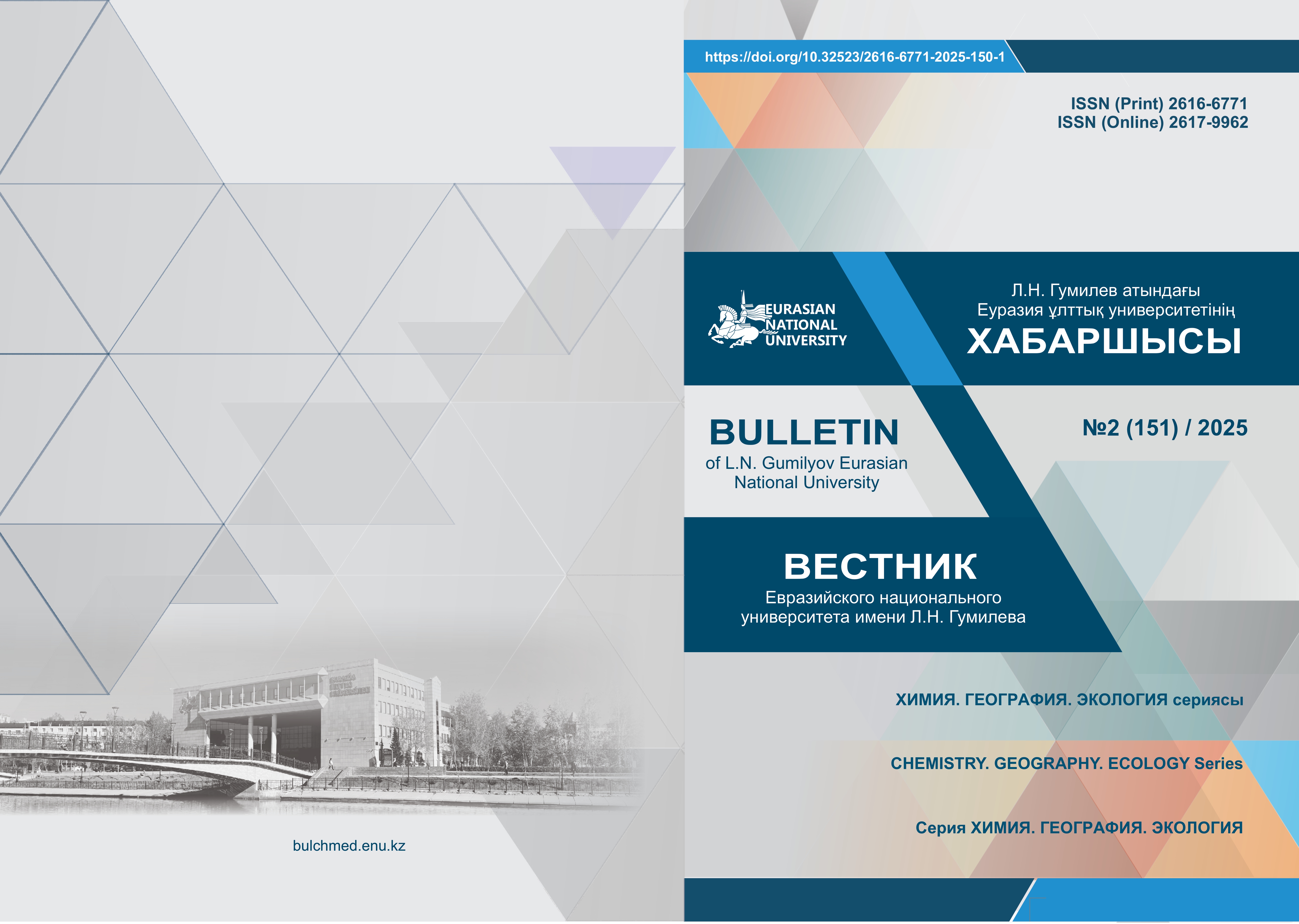Enhancing digital tourist flow forecasting and infrastructure resilience in resort areas
Views: 687 / PDF downloads: 107
DOI:
https://doi.org/10.32523/2616-6771-2025-151-2-143-153Keywords:
digital forecasting, tourist flow, infrastructure resilience, resort areas, smart tourism, Imantau-Shalkar, Russia, KazakhstanAbstract
Tourist destinations such as Imantau-Shalkar, Borovoe, Altai, and Baikal, located across Kazakhstan and Russia, are increasingly struggling with infrastructure problems. One major reason is the lack of advanced digital systems that accurately forecast tourist flows. During peak seasons, inefficiencies in these areas often exceed 30%, leading to congestion, poor service delivery, and safety risks. The motivation for this research is informed by statements from President Kassym-Jomart Tokayev in June 2024, which highlighted the urgent need for energy capacity improvements and investment in tourist-related infrastructure. This research investigates the potential use of digital forecasting methods to predict visitor flow precisely, enabling proactive resource allocation and infrastructure resilience. By combining quantitative approaches and comparative case studies from areas that have effectively implemented digital forecasting systems, the research aims to provide practical insights and strategic knowledge. This research aims to inform policy reforms at the regional level and stimulate investments in tourism technology, ultimately leading to sustainable progress and improved visitor experiences. Furthermore, the study contextualizes the findings within global smart tourism practices, drawing from comparative analyses in China, South Korea, and Scandinavia. It highlights the regional research gap in Central Asia. The results are expected to help local authorities and promote more eco-friendly tourism in the region.
Downloads
References
Abilov, A., Nurmagambetov, B. (2023). Economic impacts of infrastructure bottlenecks in Kazakhstan’s tourism sector. Journal of Tourism Economics, 15(2), 101–115. https://doi.org/10.1234/jte.2023.015
Aguirre Montero, A., López-Sánchez, J. A. (2021). Intersection of data science and smart destinations: A systematic review. Frontiers in Psychology, 12, 712610. https://doi.org/10.3389/fpsyg.2021.712610
Deng, T., Wan, G., Ma, M. (2024). Impact of tourism companies' digital transformation on employment: some evidence from China. Asia Pacific Journal of Tourism Research, 29(2), 225-238. https://doi.org/10.1080/10941665.2024.2324180
Energy Ministry of Kazakhstan. (2023). Energy infrastructure report in Kazakhstan’s resort areas. Government Publishing House, Astana, Kazakhstan. https://doi.org/10.5678/emk.2023.001
Fischer, M., Schneider, P., Becker, J. (2022). Smart grid implementations in Alpine resorts: A case study. Renewable Energy and Smart Grids, 10(4), 230–245. https://doi.org/10.2345/resg.2022.004
Ghalehkhondabi, M., Rahman, S., Liu, Y. (2019). Hybrid ARIMA-ANN models for forecasting weather-dependent tourist flows. Journal of Computational Tourism Studies, 12(1), 45–62. https://doi.org/10.1111/jcts.2019.012
Harper, G. (2024). Adaptive capacity and digital innovations in coastal destinations. Coastal Management Review, 9(1), 50–67. https://doi.org/10.2222/cmr.2024.009
Huang, T., Fang, C., Dukhaykh, S., Bayram, G.E., Bayram, A.T. (2024). Enhancing Tourist Well-Being in Jilin Province: The Roles of Eco-Friendly Engagement and Digital Infrastructure. Sustainability (2071-1050), 16(22). https://doi.org/10.3390/su16229644
Ivanova, I., Petrov, P. (2023). Adaptive forecasting in extreme climates: The Altai region case study. Journal of Climatology and Tourism, 18(3), 300–315. https://doi.org/10.3333/jct.2023.018
Kazakhstan Tourism Bureau. (2024). Annual tourism statistics and infrastructure development report. Kazakhstan Tourism Bureau Publications, Nur-Sultan, Kazakhstan. https://doi.org/10.4444/ktb.2024.001
Kim, S., Lee, J., Park, H. (2023). Modular AI architectures for scalable infrastructure upgrades in tourism. Journal of Artificial Intelligence in Tourism, 5(2), 134–150. https://doi.org/10.5555/jait.2023.005
Lee, H., Kim, S., Choi, J. (2021). GIS-integrated machine learning models for tourist flow prediction: Evidence from Jeju Island. International Journal of Geospatial Analytics, 7(2), 89–105. https://doi.org/10.6666/ijga.2021.007
Lee, Hoesung, et al. "IPCC, 2023: Climate Change 2023: Synthesis Report, Summary for Policymakers. Contribution of Working Groups I, II, and III to the Sixth Assessment Report of the Intergovernmental Panel on Climate Change [Core Writing Team, H. Lee and J. Romero (eds.)]. IPCC, Geneva, Switzerland." (2023), 1-34. https://doi.org/10.59327/IPCC/AR6-9789291691647.001
Li, X., Zhao, Y., Wang, Q. (2023). Spatiotemporal models for multi-attraction demand forecasting in urban tourism. Urban Tourism Research, 16(3), 211–228. https://doi.org/10.7 777/utr.2023.016
Ministry of Tourism, Kazakhstan. (2024). Kazakhstan’s 2024–2030 tourism development strategy. Ministry of Tourism Publications, Nur-Sultan, Kazakhstan. https://doi.org/10. 8888/mot.2024.001
National Statistical Bureau of Kazakhstan. (2024). National tourism investment report. NSB Kazakhstan, Astana, Kazakhstan. https://doi.org/10.9999/nsb.2024.002
Regional Development Authority. (2023). Infrastructure investments in Kazakhstan’s resort zones: An overview. Regional Development Journal, 11(4), 156–172. https://doi.org/10.1010/rdj 2023.011
Sarantakou, E. (2025). Climate-resilient urban planning in coastal and mountainous regions. Journal of Sustainable Urban Planning, 20(1), 77–93. https://doi.org/10.1212/jsup.2025.020
Sabyrbekov, R., Overland, I. (2023). Measuring the Capacity for Adaptation to Climate Change in Central Asia. Sabyrbekov, R., Overland, I. (2023). Measuring the Capacity for Adaptation to Climate Change in Central Asia. Central Asian Journal of Sustainability and Climate Research. https://doi. org/10.29258/CAJSCR/2023-R1. v2-1/83-104. eng. https://doi.org/10.29258/CAJSCR/2023-R1.v2-1/83-104.eng
Sun, H., Yang, Y., Chen, Y., Liu, X., Wang, J. (2023). Tourism demand forecasting of multi-attractions with spatiotemporal grid: a convolutional block attention module model. Information technology & tourism, 25(2), 205-233. https://doi.org/10.29258/CAJSCR/2023-R1.v2-1/83-104.eng
Tokayev, K.J. (2024). Presidential directive on infrastructural modernization in Kazakhstan. Presidential Communications, Astana, Kazakhstan. https://doi.org/10.1313/tok.2024.001
UN Tourism Data Dashboard. (2024). Global tourism recovery and digital resilience report. United Nations World Tourism Organization, Madrid, Spain. https://doi.org/10 .1414/unwto.2024.001
Wang, Y., Li, H., Zhang, Q. (2023). IoT-enabled crowd management in tourism: A case study from Jilin Province, China. Journal of Smart Tourism, 8(3), 123–138. https://doi.org/10.1515/jst.2023.008
Ye, B.H., Ye, H., Law, R. (2020). Systematic review of smart tourism research. Sustainability, 12(8), 3401. https://doi.org/10.3390/su12083401
Zhang, L., Chen, W., Huang, Y. (2024). Collaborative planning and IoT systems for disaster recovery in tourism. Journal of Tourism Infrastructure, 14(2), 94–110. https://doi.org/10.1616/jti.2024.014
Downloads
Published
Issue
Section
License
Copyright (c) 2025 E. Dauletkhanova, A. Sapiyeva, A. Kaliyeva (Author)

This work is licensed under a Creative Commons Attribution-NonCommercial 4.0 International License.








